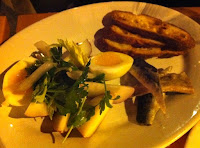Like many city folk, I've left lots of my life's tasks to the more able hands of others. Vehicle maintenance, sewing my own clothing and remodeling the house among them. I delved into butchering meat with Roger the pig. But I'd always delegated cleaning crabs to the person behind the fish counter at the store because it was easier and, frankly, because I didn't want to deal with the "yuck" factor of the gooey bits.
Pulling off the back (called the "plate").
Then more adventurous friends started buying live crabs, boiling them in a big pot and cleaning them, all the while insisting that it wasn't that bad and was simple to boot. So one day I decided to bite the bullet, and when the clerk asked if I'd like it cleaned, I said, "No, thanks. I'll do it myself." Her look of surprise and respect was totally worth it even if it turned into a fiasco once I got the buggers home.
Plate off, about to get cleaned.
Luckily, our West Coast Dungeness crabs are relatively big and easy to handle. So since it was already cooked, all it took was holding the crab over the sink with the rear of it toward me. I put my thumbs on either side of the body and popped the back plate off. Then I pulled off the feathery white lungs and discarded them and, since I don't use the greenish-yellow stuff called the "tomalley" (it's actually the crab's liver and some people love it), I just ran it briefly under cold water to wash it out. There are usually some bony bits at the front that I tear off, too.
See? That wasn't so bad!
With the crab essentially cleaned at that point, I broke off the legs and cracked the central body in half to make it easier to get the meat out. My friend Hank Shaw wrote and illustrated step-by-step instructions on how to pick the crab meat, so if you need help on that front check out his guide.
Parted out and ready to pick.
With the macho work done, I decided to kick off the Crustacean Celebration this year with a warm and comforting chowder. The weather had been pretty rainy and cold, and I'd seen several recipes that paired corn and crab. So a creamy soup using those two ingredients seemed like a natural fit.
If you do decide to impress your local fishmonger, not to mention your friends and family, with your courage and perspicacity by cleaning your own, you'll have something delicious to show for it when you tell your tale of derring-do.
Corn and Crab Chowder
2 Tbsp. butter or margarine
1 onion, chopped fine
2 cloves garlic, minced
3 potatoes, chopped into 1/2" dice
2 c. fresh or frozen corn kernels
4 c. fish stock or corn stock
2 c. milk
Meat from 1 large crab, about 1/2-1 lb.
Salt and pepper to taste
Melt butter or margarine in soup pot over medium heat. Add onion and garlic and sauté till translucent, then add potatoes and sauté till potatoes are nearly tender. Add corn and stir to bring up to temperature, then pour in stock and milk. Add salt and pepper to taste. Bring to simmer and cook until potatoes are completely tender and flavors have melded together. Adjust salt and pepper to taste. At this point you can add the crab to the pot until it's just warmed (a minute or less), or divide the crab meat between serving bowls and pour the hot chowder over the top. (The point is to keep the crab as succulent as possible…by the time you get it to the table the crab in the bowls will be warm.)
This year's Crustacean Celebration also features a fabulous Beach Cioppino and Crab Niçoise. Read last season's series starting with And They're Off!, and the previous year's series kicking off with a Hot Artichoke and Crab Dip (with links to other posts in the series).










































